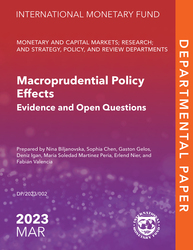
Macroprudential Policy Effects: Evidence and Open Questions
This paper takes stock of our expanding understanding about the effects (and side effects) of macroprudential measures..
READ MORE...
Volume/Issue:
Volume 2023
Issue 002
Publication date: March 2023
ISBN: 9798400226304
$20.00
Add to Cart by clicking price of the language and format you'd like to purchase
Available Languages and Formats
| English |
Topics covered in this book
This title contains information about the following subjects.
Click on a subject if you would like to see other titles with the same subjects.
Banks and Banking , Finance , Economics- Macroeconomics , Money and Monetary Policy , International - Economics , Public Policy , macroprudential policy financial stability , policy effect , IMF Library , Macroprudential effect , Macroprudential buffer , Macroprudential Policy database , Macroprudential policy , Macroprudential policy instruments , Credit , Countercyclical capital buffers , Bank credit , Global
Summary
The global financial crisis (GFC) underscored the need for additional policy tools to safeguard financial stability and ultimately macroeconomic stability. Systemic financial vulnerabilities had developed under a seemingly tranquil macroeconomic surface of low inflation and small output gaps. This challenged the precrisis view that achieving these traditional policy targets was a sufficient condition for macroeconomic stability. Thus, new tools had to be deployed to target specific financial vulnerabilities and to build buffers to cushion adverse aggregate shocks, while allowing traditional policy levers, including monetary and microprudential policies to focus on their traditional roles. Macroprudential policy measures emerged as the solution to this gap. Some of these measures had been used before the GFC (mostly in emerging markets). But it was only after the crisis that they were more widely adopted, and the toolkit expanded. This spurred a growing body of empirical research on the effects and potential shortfalls of these measures, with a further deepening of this knowledge gaining importance as policymakers confront increased financial stability risks in the post-pandemic world. Recognizing that there still is much to learn, this paper takes stock of our expanding understanding about the effects (and side effects) of macroprudential measures by focusing on these questions: What have we learned about the effects of macroprudential policy in containing the buildup of vulnerabilities? What do we know about the effects on economic activity and resilience? How do policy effects vary with conditions and over time? How important are leakages and circumvention? How do the effects on credit depend on other policies?
Copyright © 2010 - 2025
Powered by:
AIDC



